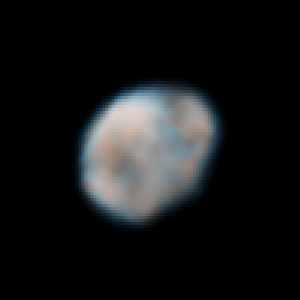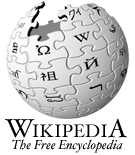 |
This is a file from the Wikimedia Commons. Information from its description page there is shown below.
Commons is a freely licensed media file repository. You can help.
|
| Description |
To prepare for the Dawn spacecraft's visit to Vesta, astronomers used Hubble's Wide Field Planetary Camera 2 to snap new images of the asteroid. The image was taken on May 14 and 16, 2007. Using Hubble, astronomers mapped Vesta's southern hemisphere, a region dominated by a giant impact crater formed by a collision about a billion years ago. The crater is 285 miles (456 kilometers) across, which is nearly equal to Vesta's 330-mile (530-kilometer) diameter. If Earth had a crater of proportional size, it would fill the Pacific Ocean basin. The impact broke off chunks of rock, producing more than 50 smaller asteroids that astronomers have nicknamed "vestoids." The collision also may have blasted through Vesta's crust. Vesta is about the size of Arizona. |
| Date |
Images taken 2007 May 14 and 16 |
| Source |
http://hubblesite.org/newscenter/archive/releases/2007/27/image/a/, http://hubblesite.org/newscenter/archive/releases/2007/27/image/c/ |
| Author |
NASA; ESA; L. McFadden and J.Y. Li (University of Maryland, College Park); M. Mutchler and Z. Levay (Space Telescope Science Institute, Baltimore); P. Thomas (Cornell University); J. Parker and E.F. Young (Southwest Research Institute); and C.T. Russell and B. Schmidt (University of California, Los Angeles) |
Permission
( Reusing this file) |
Unless otherwise specifically stated, no claim to copyright is being asserted by STScI and it may be freely used as in the public domain in accordance with NASA's contract. [...]
|
| Public domainPublic domainfalsefalse |
 |
This file is in the public domain because it was solely created by NASA. NASA copyright policy states that "NASA material is not protected by copyright unless noted". (See Template:PD-USGov, NASA copyright policy page or JPL Image Use Policy.) |
|
|
|
Warnings:
- Use of NASA logos, insignia and emblems are restricted per US law 14 CFR 1221.
- The NASA website hosts a large number of images from the Soviet/ Russian space agency, and other non-American space agencies. These are not necessarily in the public domain.
- Materials based on Hubble Space Telescope data may be copyrighted if they are not explicitly produced by the STScI. See also {{ PD-Hubble}} and {{ Cc-Hubble}}.
- The SOHO (ESA & NASA) joint project implies that all materials created by its probe are copyrighted and require permission for commercial non-educational use.
- Images featured on the Astronomy Picture of the Day (APOD) web site may be copyrighted.
|
File usage
The following pages on Schools Wikipedia link to this image (list may be incomplete):
This file contains additional information, probably added from the digital camera or scanner used to create or digitize it. If the file has been modified from its original state, some details may not fully reflect the modified file.
SOS Childrens Villages has brought Wikipedia to the classroom. By supporting vulnerable children right through to adulthood, SOS Children makes a lasting difference to the lives of thousands of people. Education is a key part of our work, and our schools provide high-quality teaching to the children in our care. Will you help another child today?





